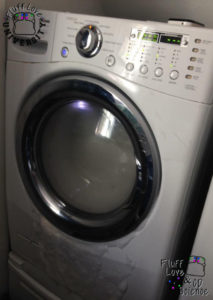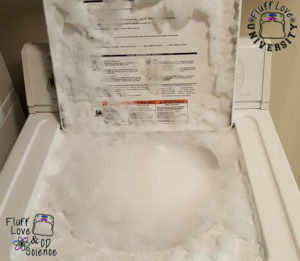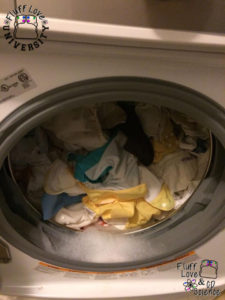The Basics
We often provide advice on washing diapers in hard water, but soft water can present its own set of challenges. For most, having soft water just means that you don’t have to add water softener to your wash routine. However, because soft water can cause your detergent to create more suds, those with very suds-sensitive washers (particularly certain front loading HE machines) may face some difficulties when washing in soft water. Don’t get frustrated! We have plenty of tips to help.
Whether your soft water is naturally-occurring or due to an in-home water softening system you will treat it the same. If you have a water softener, remember to test your water at the washing machine to confirm it’s being adequately softened (some water is so hard, a softening system doesn’t soften it enough to wash without borax or Calgon in your wash routine), and make sure that your softener is properly maintained to ensure it’s always working properly.
If your water test reads soft (50 ppm or less), you can use any recommended detergent without needing water softener. At around 60 ppm, plant based detergents and most free and clear detergents will need a water softener added to the main wash only– this is why we always recommend testing your water to get an accurate hardness reading. Observations about how your water feels, how much your soap or detergent lathers and/or rinses, or how many suds you see do not provide enough information about the mineral content of your water. You need to test your water or have it tested to find out the total or general hardness (also known as general hardness).
In most cases, soft water just means that you can follow a basic wash routine without worrying about water hardness or needing to add water softener. Pay attention to suds problems, as excess suds in your washing machine can create a “cushion” that prevents agitation. Newer washers, particularly high-efficiency machines, will let you know when there are excess suds by displaying a “suds” error, which will either cause the cycle to pause (or cancel the cycle completely) to allow suds to clear or add extra rinses to clear the suds. Suds errors can be hard on your washer as the drain pump can become overwhelmed with suds, so you should take steps to avoid them. It is rare, but possible, to oversuds a standard washer. This usually occurs due to use of a very sudsy detergent such as Foca powder or Gain powder in soft water, especially combined with a dirty washer or a clogged drain hose. It can also be made worse by poor agitation, like when you don’t have the appropriate diaper to water ratio. Be sure to check out our Suds and Bubbles page for more science goodness!
-

Front Loading HE washer oversuds
-

Top Loading non-HE washer oversuds
Detergents and Additives
Extra Rinses are Cool, Right? Not Exactly.
-
Soft water usually causes more suds and can leave residual suds behind. This is not an issue unless you diapers still feel slimy, like a wet bar of soap, or are full of suds at the end of your wash (when all of the water has drained). Slimy diapers indicate that the detergent is not fully rinsed, and this usually indicates lack of agitation. Suds in the door of a front loader is pretty normal. If you have a standard washer, make sure you are using the proper load size and checking for proper consistency (for tips on load size and stew, please see our file on washing in non-HE machines). If you have a HE machine, make sure you are loading your machine the proper amount, either 1/2, 2/3, or 3/4 full depending on what washer you have. Check out our file on washing in HE machines for more details.

Normal suds in a front loading HE machine
If your diapers FEEL slimy, you can run an extra rinse as a one-time quick fix until you solve the underlying problem. Because all water, even soft, carries some minerals, using an extra rinse every single time could cause you some issues down the road. Getting to the root of the slime problem will also help you save on resources and be able to skip that extra rinse!
What About Stripping?
All water contains minerals. Even soft water will usually contain traces of calcium, limescale, magnesium, and/or iron. Usually, detergent alone is effective enough to keep these things from depositing in your diapers and causing issues. However, if your water is very low in some minerals, but still has significant amounts of others, you can still have water that tests as “soft,” even though there are minerals present. Stripping is a solution to address poor wash routines, especially to address washing long term in hard water without using water softener. Stripping also addresses issues of washing with soap or a non-recommended detergent. Therefore, even those with soft water may need to strip and bleach to address long term issues. Even though the stripping agents are normally used as water softeners, you still need to use all of them in your strip. In the context of a strip, they aren’t used to soften the water, but to break up the mineral and/or soap deposits so they can be effectively washed away. See our pages on How to Strip Cloth Diapers and The Science of Stripping for more information.
REMEMBER, YOU SHOULD *NEVER* NEED TO STRIP IF YOUR WASH ROUTINE IS SOLID. You may need to strip if you’re buying used diapers from someone who used weak/homemade detergent, used Charlie’s Soap, or who had hard water.
How to Troubleshoot a Suds Error
Clean Your Washer
Clean your washer after every suds error. After an error the washer and drain hoses can be filled with suds and residue. The error may recur if you do not clean your washer. Be sure to check your owner’s manual to find out if your washer has a filter, as a clogged filter can prevent proper draining and cause a suds error. If you have an extreme suds error that causes the suds to leak out of the washer onto the floor, manually remove as many of the suds as you can before cleaning your washer. You may want to also run a rinse and spin with the diapers, to remove some of the suds and excess water from them before you try to wash again. Once you clean your washer, try re-washing your diapers. You may want to work with a FL&CDS admin or peer advisor for help in troubleshooting the cause of the suds error.
Check Your Detergent
A common cause of suds errors is accidentally using non-HE detergent in a HE machine.
Check Your Load Size/Bulk
Lack of agitation can cause excess suds. If you are under or over-filling the machine with too much laundry you may experience suds errors. Some machines are more sensitive than others. If you have a front loader make sure it’s 2/3 – 3/4 full.
Skip the Dispenser
Because the detergent dispenser dispenses the detergent by shooting water at the reservoir to clear the detergent out, it can create more suds. Try putting your detergent directly in the drum with your laundry.
Try Warm or Cold Water
As long as you’re not using plant-based detergent, you can try cold or warm water in your main wash. Hot water creates more suds, and cold or warm water can help combat a suds error.
Wash More Often
Diapers are small and absorbent and suds more than other laundry. If your load is mostly diapers, it can push things over the edge into a suds error. Try washing daily or every other day, and adding less absorbent items like clothing to get your washer full enough.
Skip the Prewash Detergent
This one feels counterintuitive. However, prewash detergent really doesn’t have much cleaning power and mostly functions to fight minerals in hard water. For those with very soft water, eliminating detergent from the prewash can stop the suds errors from the main wash.
Give Vinegar a Try
*This is only recommended for those with a pH of 9 or higher* Test your water’s pH before trying vinegar. Vinegar is acidic, and if it is used regularly in acidic water (low pH), your diapers will wear significantly faster. Vinegar can help fight suds, so if your water’s pH is 9 or higher you can try adding vinegar as a rinse aid, in your fabric softener slot. In alkaline water the vinegar balances the pH, and it should not wear your diapers out faster than a person washing in water with a neutral pH.
Switch Detergents
If these tricks don’t work, we may need to talk about switching detergents. Not every detergent works in every situation. Work with a FL&CDS admin or peer advisor to discuss your options. Persistent suds errors can also be a sign that your washer needs to be serviced.
Go Kick Soft Water’s Butt!
Need even more help? Itching to join the conversation? Check out our Facebook group, Fluff Love & CD Science.
